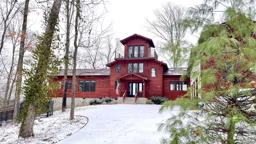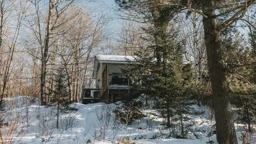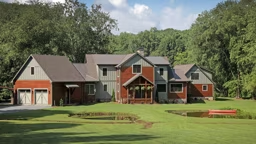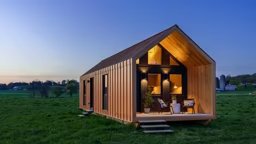For Jim and Esther Whitman, when it comes to their limited free time they’re all about simple living. Because their hectic work lives revolve around their complex biotech business, for years they were satisfied with a modified travel trailer situated on the bay. It dutifully provided the no-hassle, low-impact getaway experience they value.
“We liked the location,” says Esther, and there’s plenty to like. The camper sat on their private lot at a family campground in Horntown, Va. With the campsite a few miles away from the temperamental ocean, they knew their vacation spot would be protected from hurricanes. And knowing the campground patrol kept vandals away left little to worry about. This freed the couple to enjoy the striking views of Chincoteague Island with its wild ponies, renowned bird life and mesmerizing, multicolored marshland. “But the trailer was 30 years old and it was simply starting to fall apart,” says Esther.
Turning Wheels
Although the Whitman’s camper had been modified to include a roof and a lean-to porch, they wanted something less confining. Yet they still valued a vacation place easy on resources and maintenance.
When the campground amended its bylaws allowing “non-wheeled structures” on the property, the wheels literally started turning. “We gave our trailer away to someone who wanted to fix it up and use it,” says Esther. It pleased both she and Jim to know it would be of further use and effectively cleared the way for change.
The couple connected with Robbin Obomsawin of Beaver Creek Log Homes in Oneida, N.Y. Well known in the world of log construction, Robbin has written several books, including “Small Log Homes” – a theme close to her heart. The basic premise is that with good design, and an efficient use of space and materials, one can get more enjoyment out of a smaller structure for less money and upkeep. Robbin’s philosophy spoke to the Whitmans on every level.
Robbin’s plan was to make use of the lean-to structure that remained after the trailer had been pulled. “She didn’t completely tear down the existing half structure; she built the new cottage under the existing roof,” explains Esther. “The basic structure was still there, but where the old trailer had been became our little southern cottage.”
“We liked the location,” says Esther, and there’s plenty to like. The camper sat on their private lot at a family campground in Horntown, Va. With the campsite a few miles away from the temperamental ocean, they knew their vacation spot would be protected from hurricanes. And knowing the campground patrol kept vandals away left little to worry about. This freed the couple to enjoy the striking views of Chincoteague Island with its wild ponies, renowned bird life and mesmerizing, multicolored marshland. “But the trailer was 30 years old and it was simply starting to fall apart,” says Esther.
Turning Wheels
Although the Whitman’s camper had been modified to include a roof and a lean-to porch, they wanted something less confining. Yet they still valued a vacation place easy on resources and maintenance.
When the campground amended its bylaws allowing “non-wheeled structures” on the property, the wheels literally started turning. “We gave our trailer away to someone who wanted to fix it up and use it,” says Esther. It pleased both she and Jim to know it would be of further use and effectively cleared the way for change.
The couple connected with Robbin Obomsawin of Beaver Creek Log Homes in Oneida, N.Y. Well known in the world of log construction, Robbin has written several books, including “Small Log Homes” – a theme close to her heart. The basic premise is that with good design, and an efficient use of space and materials, one can get more enjoyment out of a smaller structure for less money and upkeep. Robbin’s philosophy spoke to the Whitmans on every level.
Robbin’s plan was to make use of the lean-to structure that remained after the trailer had been pulled. “She didn’t completely tear down the existing half structure; she built the new cottage under the existing roof,” explains Esther. “The basic structure was still there, but where the old trailer had been became our little southern cottage.”
Beauty of Small
Due to zoning restrictions, the new cottage could not be bigger than the previous structure. Robbin’s design squeezed in a galley kitchen, living room and two bedrooms in the 800-square-foot space. “The master bedroom is just big enough for a king size bed and we can still walk around it,” laughs Esther.
Tucking a small on-demand water heater in the attic also saved precious square footage. Like the other mechanicals and appliances, it was chosen for both energy and space conservation. “The whole cottage is very efficient and well insulated,” says Jim. “Our utility bills are so low, it’s amazing.” Electricity runs between $5 to $12 per month and the water bill is only $33 per month.
To bring the outside in, Robbin designed a screened-in porch, along with a bump-out window (which was exempted by local authorities). These clever additions also lengthen the sightline across the cottage making the small space feel roomier. “We can look out over the marsh and see the lighthouse and causeway a half a mile away,” says Esther. “It’s beautiful.”
Also giving the little butter-yellow cottage a sense of airiness was the simple addition of awnings above the windows. Because the windows are sheltered, the Whitmans have fresh air circulating even in rainy conditions.
Due to zoning restrictions, the new cottage could not be bigger than the previous structure. Robbin’s design squeezed in a galley kitchen, living room and two bedrooms in the 800-square-foot space. “The master bedroom is just big enough for a king size bed and we can still walk around it,” laughs Esther.
Tucking a small on-demand water heater in the attic also saved precious square footage. Like the other mechanicals and appliances, it was chosen for both energy and space conservation. “The whole cottage is very efficient and well insulated,” says Jim. “Our utility bills are so low, it’s amazing.” Electricity runs between $5 to $12 per month and the water bill is only $33 per month.
To bring the outside in, Robbin designed a screened-in porch, along with a bump-out window (which was exempted by local authorities). These clever additions also lengthen the sightline across the cottage making the small space feel roomier. “We can look out over the marsh and see the lighthouse and causeway a half a mile away,” says Esther. “It’s beautiful.”
Also giving the little butter-yellow cottage a sense of airiness was the simple addition of awnings above the windows. Because the windows are sheltered, the Whitmans have fresh air circulating even in rainy conditions.
Right Down to the Toothpaste
Jim Whitman admits it’s part of his makeup to be “very practical and conservative” when it comes to resources. “The kids make fun of it. We still have stuff from when we got married and I tend to wear shoes until they fall off my feet,” he says. “We could have done the trophy cottage, but we’re not interested in that.”
So one of the most important construction points for the Whitmans was the use of recycled materials wherever possible. Robbin scoured her barn for scrap supplies left over from previous projects and found plenty of exterior cedar – a good choice to handle saltwater and harsh weather conditions. The interior benefited from her stash of excess bead board, which was whitewashed to give it an aged effect. “It brought out all the knots, which is a very pretty detail,” says Esther.
Robbin was happy to oblige. In fact, she takes pride in knowing the small details that will make her clients happy. “By the time a project is done, I know my clients’ tastes down to the toothpaste they use,” she says. Because of such insight, Robbin was able to jump on flea market finds that would enhance the cottage knowing they would fit the Whitman’s style.
“Robbin got a little, old-fashioned wardrobe that she picked up for $50 or so,” says Esther of the piece that’s now painted a whimsical color to fit seamlessly into the relaxed beach house setting. It goes well with the Whitmans’ grandsons’ bunk beds, a long-held dresser the couple bought from a student woodshop when they were first married and the inexpensive painted kitchen cabinets.
“Everything in the cottage is used, reclaimed, yard-sale finds or discounted store stock,” says Robbin. “It’s the inexpensive combination of materials and repurposed junk that makes this cottage work without feeling fake or contrived.”
Robbin knew her project was successful when the building inspector came through. “He was so stunned by the feel of the cottage. He said the cottage looked as though someone locked the door for 80 years and just opened it to a charming, 1920s or 30s beach house ... like time stood still.”
Good Fit
The new, easy-to-maintain getaway has left the Whitmans free to walk through their scenic campground, by the nearby ocean and through the nature preserves. They enjoy watching the area’s abundant wildlife, particularly birds, as they explore their coastal playground by foot.
Jim says the cottage fits well not only into the landscape, but also fits with the values that attract him to this natural area. “We want to live the way the world will have to go – with smaller carbon footprints, smaller houses, smaller cars, smaller everything … .”
Maine native Lucie Amundsen, now landlocked in Minnesota, loves the salty smell of coastal cabins.
Jim Whitman admits it’s part of his makeup to be “very practical and conservative” when it comes to resources. “The kids make fun of it. We still have stuff from when we got married and I tend to wear shoes until they fall off my feet,” he says. “We could have done the trophy cottage, but we’re not interested in that.”
So one of the most important construction points for the Whitmans was the use of recycled materials wherever possible. Robbin scoured her barn for scrap supplies left over from previous projects and found plenty of exterior cedar – a good choice to handle saltwater and harsh weather conditions. The interior benefited from her stash of excess bead board, which was whitewashed to give it an aged effect. “It brought out all the knots, which is a very pretty detail,” says Esther.
Robbin was happy to oblige. In fact, she takes pride in knowing the small details that will make her clients happy. “By the time a project is done, I know my clients’ tastes down to the toothpaste they use,” she says. Because of such insight, Robbin was able to jump on flea market finds that would enhance the cottage knowing they would fit the Whitman’s style.
“Robbin got a little, old-fashioned wardrobe that she picked up for $50 or so,” says Esther of the piece that’s now painted a whimsical color to fit seamlessly into the relaxed beach house setting. It goes well with the Whitmans’ grandsons’ bunk beds, a long-held dresser the couple bought from a student woodshop when they were first married and the inexpensive painted kitchen cabinets.
“Everything in the cottage is used, reclaimed, yard-sale finds or discounted store stock,” says Robbin. “It’s the inexpensive combination of materials and repurposed junk that makes this cottage work without feeling fake or contrived.”
Robbin knew her project was successful when the building inspector came through. “He was so stunned by the feel of the cottage. He said the cottage looked as though someone locked the door for 80 years and just opened it to a charming, 1920s or 30s beach house ... like time stood still.”
Good Fit
The new, easy-to-maintain getaway has left the Whitmans free to walk through their scenic campground, by the nearby ocean and through the nature preserves. They enjoy watching the area’s abundant wildlife, particularly birds, as they explore their coastal playground by foot.
Jim says the cottage fits well not only into the landscape, but also fits with the values that attract him to this natural area. “We want to live the way the world will have to go – with smaller carbon footprints, smaller houses, smaller cars, smaller everything … .”
Maine native Lucie Amundsen, now landlocked in Minnesota, loves the salty smell of coastal cabins.
 Fred Schilling
Fred Schilling 











